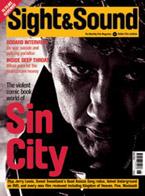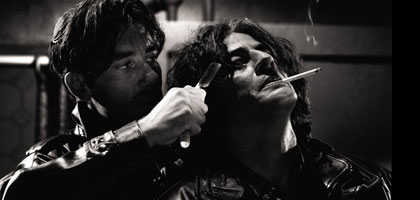
Sin City
USA 2005

Reviewed by Kim Newman
Synopsis
Our synopses give away the plot in full, including surprise twists.
Basin City, a town so corrupt it is often called 'Sin City'. A smooth assassin (the Man) ( Josh Hartnett) murders Becky (Alexis Bledel), a woman he has been paid to kill but who thinks he loves her.
John Hartigan (Bruce Willis), an honest but ailing cop, mutilates Roark Jr (Nick Stahl), a serial rapist-murderer who is the son of a powerful senator, saving 11-year-old Nancy Callahan (Jessica Alba), but he is shot in the back by his partner.
Some years later, Marv (Mickey Rourke), a hulking ex-con, has a night of love with Goldie (Jaime King), a gorgeous woman who is promptly murdered. Escaping from cops who arrive to pin the crime on him, Marv goes to Lucille (Carla Gugino), his sympathetic parole officer, and explains that Goldie gave herself to him because she knew she was being targeted and only he would be tough enough to avenge her. When thugs come for him, Marv tortures them for information. He learns that Goldie's killer is Kevin (Elijah Wood), a cannibal who lives on a farm owned by Cardinal Roark (Rutger Hauer), the senator's even more powerful brother. Lucille is killed by Roark's men, but Marv gets the better of Kevin, letting his own pet wolf eat him. Marv kills the Cardinal, but takes the rap for all the murders and goes to the electric chair. Only Wendy (Jaime King), Goldie's twin sister, knows he has acted heroically.
Dwight (Clive Owen), a fugitive with a face changed by plastic surgery, is in a relationship with Shellie (Brittany Murphy), a waitress. Her apartment is invaded by Jackie (Benicio Del Toro), an abusive ex-boyfriend whom Dwight humiliates. Worried that Jackie and his friends will take their anger out on innocents, Dwight trails them to Old Town, an area run by 'the Ladies', a gang of tough prostitutes queened by his ex-girlfriend Gail (Rosario Dawson). Miho (Devon Aoki), Gail's samurai-sword-wielding enforcer, chops off Jackie's gun hand, but he uses his other hand to try to shoot Dwight. Miho has blocked Jackie's barrel and the backfire kills him, whereupon it turns out he was a cop. This killing is liable to break the truce that has allowed the Ladies to run their own turf. Becky, a treacherous hooker, tells Manute (Michael Clarke Duncan), a mobster, about the situation. Manute sends Irish mercenaries to prevent Dwight from disposing of Jackie's body. However, Dwight gets away with Jackie's head. Dwight and Miho offer to exchange the head for the captured Gail, and the Ladies wipe out the mobsters, reasserting the independence of Old Town.
A little earlier, Hartigan is in jail for his assault on Roark Jr, kept sane by weekly letters from Nancy. When a disfigured 'yellow bastard' appears in his cell with a girl's severed finger, Hartigan confesses to Junior's crimes and is released, then traces Nancy, who is now an exotic dancer. Glimpsing the yellow bastard at the bar, Hartigan realises he has been duped and has led Nancy's former molester to her. Overpowering them, Junior leaves Hartigan to hang and begins to torture Nancy, but Hartigan escapes and batters him to death. Knowing Nancy is in danger as long as he lives, Hartigan sends her home and shoots himself.
The smooth assassin meets Becky and begins charming her for the kill.
Review
Writer-artist Frank Miller, who became a star in mainstream superhero comics with a run on Marvel's Daredevil, was hard done by in the credits of the Daredevil and Elektra films, which make near-unacknowledged use of characters he created on a work-for-hire basis. He has no cause to complain of any slight in this adaptation of his creator-owned property: not only does Miller rate a co-director credit with Robert Rodriguez - who privileges him as a co-creator in an otherwise one-man-band production much as Orson Welles did cinematographer Gregg Toland on Citizen Kane - but almost every sequence uses the original panels as storyboard, and a combination of make-up, CGI and lighting effects transforms the cast into the images of their on-the-page originals. Mickey Rourke might have his highest-profile role in years, but his physical profile is utterly changed by a prosthetic appliance that gives him the concrete features of the books' Marv, a character who reveals the breadth of Miller's influences by coming on like a crossbreed of Moose Malloy, the hulking ex-con who hires Marlowe to find his lost love in Farewell My Lovely, and the rock-skinned Thing of The Fantastic Four.
Sin City is one of several recent films (Sky Captain and the World of Tomorrow, Casshern) which abjure traditional sets in favour of placing the cast into computer-generated, photo-realistic artwork. While there is still something fakey in the use of CGI to depict the ancient world in Gladiator or Alexander, this technique works well when dealing with a stylised, self-contained fantasy world. A comic-book film doesn't need to be as eye-deceivingly realistic as an epic; indeed, part of the appeal is in showing things that can't be real in a manner calculated to astonish rather than convince. In his superhero work, Miller tended to use urban vigilante characters like Daredevil and Batman, drawing on the cityscapes of filmr(mutating in the 1980s into the retro-futuristic environments of cyberpunk) and the brutally honourable ethos of samurai or kung fu stories; whenever characters who can fly, like Superman or Thor, interact with his gritty, battered masked men, they are treated ambiguously. Miller's previous credited involvement in cinema includes the scripts for a couple of RoboCop sequels, which also conflate crime in the city with the futuristic. In Sin City, we are in a parallel world of some sort, a Silver Age Gotham City without masks and stripped of a Comics Code Authority rating, but there are few overt fantastical or science-fictional touches (beyond Marv's near-invulnerability).
If comics are predominantly concerned with boys' adolescent fantasies - nerd Peter Parker gets spider-powers and a supermodel girlfriend - then Sin City embraces this lack of maturity with a relish that is almost confrontational. Putting together three of Miller's books in a structure obviously modelled on Pulp Fiction, Rodriguez and Miller avoid the pitfall of varying the mood or tone and instead present three unstoppable hardboiled heroes who take appalling punishment while they try to protect angelic (but devastating) female innocents from irredeemably depraved villains. The Spillane paperback cover fantasy of a guy in a trenchcoat with a gun in one hand and his arm around a glamour girl has not been presented so insistently since Robert Aldrich's Kiss Me Deadly (1955). If the film were conventionally made, it might be tiresome action nonsense, but stylisation redeems the exercise, making it less an heir to Aldrich's Mike Hammer movie than the 'Girl Hunt' ballet Spillane parody (with Fred Astaire as dancing detective Rod Riley) in Vincente Minnelli's The Band Wagon (1953). Sin City is consistently gorgeous, mostly in high-gloss black and white but with the occasional striking splash of colour: the opening scene, as Josh Hartnett's predatory hit-man closes on his victim on a roof terrace overlooking the city, features a red evening dress as vivid as Cyd Charisse's in 'Girl Hunt', while Nick Stahl's horrible Roark Jr is a ghastly, sickly yellow that seems to stain the film. The most obvious effect is to have bloody wounds show red on the black and white, but the film uses that sparingly - the most ultra-violent sequences play a different game, with gushes of blood appearing as glowing white.
A side-effect of this is to highlight the way contemporary actresses are less well served than their 1940s counterparts: model-actress faces like Rosario Dawson, Jaime King, Devon Aoki and Jessica Alba, survivors of numberless teen movies and genre flicks, are revealed here as shimmering creatures, getting the full lighting and glamour treatment of Lana Turner or Lauren Bacall. Miller, creator of Elektra, has always liked women who look like exotic dancers and kill like Toshiro Mifune, and Rodriguez summoned up Selma Hayek as Santanico Pandemonium in From Dusk Till Dawn. The women of Sin City are different from the women of traditional noir, if just as objectified. The missing element is murderous duplicity: even the treacherous Becky isn't as rotten as such Chandler-scripted women as Phyllis (Barbara Stanwyck) in the film of James M. Cain's novel Double Indemnity. In Sin City, as befits the simpler morality of the comics, even whores and strippers are untouchable innocents with a sideline in lethality. The only major female character who isn't a sex worker is Marv's probation officer, a naked lesbian who has her hand eaten by a cannibal and gets casually gunned down - notably without inspiring a feeling in the man who has got her killed on a par with his devotion to the hooker who has treated him gratis to a night of sex in a heart-shaped bed with crimson sheets.
Obviously, this is a party everyone wants an invite to. Quentin Tarantino gets 'special guest director' credit for helming a single scene, involving Clive Owen in a car with Benicio Del Toro as a talking corpse. Rodriguez, who famously has a hand in everything from the music to the set catering, takes a memorable crime-comic-style 'shot and cut by' credit. Most film-makers presented with comic-book material tend to try to add 'depth', but Rodriguez and Miller are enthusiastic about a world stripped down to two dimensions, minimal even in the use of colour, with characters who have no arcs except, sometimes, from living to dead. Surprisingly few comic-book adaptations have really tried to look like comic books - Mario Bava's Diabolik and Warren Beatty's Dick Tracy come to mind - and none has so successfully seemed like a gloss on the originals as Sin City.
Credits
- Directors
- Frank Miller
- Robert Rodriguez
- Special Guest Director
- Quentin Tarantino
- Producer
- Elizabeth Avellán
- Based on the Sin City graphic novels by
- Frank Miller
- Shot by
- Robert Rodriguez
- Cut by
- Robert Rodriguez
- Art Directors
- Jeanette Scott
- Steve Joyner
- Music Composed by
- Robert Rodriguez
- John Debney
- Graeme Revell
